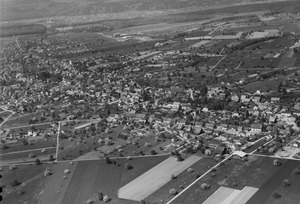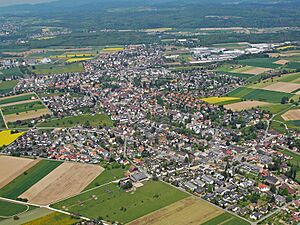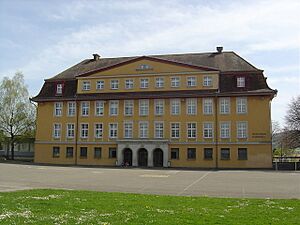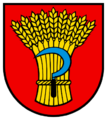Möhlin facts for kids
Quick facts for kids
Möhlin
|
||
|---|---|---|
 |
||
|
||
| Country | Switzerland | |
| Canton | Aargau | |
| District | Rheinfelden | |
| Area | ||
| • Total | 18.8 km2 (7.3 sq mi) | |
| Elevation | 310 m (1,020 ft) | |
| Population
(Dec 2020 )
|
||
| • Total | 11,088 | |
| • Density | 589.8/km2 (1,528/sq mi) | |
| Postal code |
4313
|
|
| Localities | Obermöhlin, Untermöhlin, Riburg | |
| Surrounded by | Magden, Maisprach (BL), Rheinfelden, Schwörstadt (DE-BW), Wallbach, Wehr (DE-BW), Zeiningen | |
Möhlin is a town in Switzerland, located in the Rheinfelden district. It is part of the canton of Aargau. Möhlin is a vibrant community with a rich history and beautiful natural surroundings.
Contents
- Möhlin's Past: A Look at History
- Möhlin's Landscape and Location
- Möhlin's Coat of Arms
- People of Möhlin: Population and Languages
- Important Historical Sites
- Möhlin's Economy: Work and Jobs
- Religion in Möhlin
- Getting Around: Transport in Möhlin
- Learning and Education
- Famous People from Möhlin
- Images for kids
Möhlin's Past: A Look at History
The area around Möhlin has been home to people for a very long time. Scientists have found signs of a neolithic (New Stone Age) village here. They also found items from the Bronze Age, showing people lived and worked in this area.
During the time of the Romans, there was a large farm, called an estate, in Möhlin. The Romans also built three watchtowers along the Rhine river to protect the area. Later, in the early and high Middle Ages, people used fortified places for safety.
How Möhlin Got Its Name
The town of Möhlin was first written about in the year 794. Back then, it was called Melina. In the 1200s, a knight who worked for the House of Zähringen family had the name "von Meli." This name came from Möhlin. Later, in the 1400s, a mayor of Rheinfelden also used this name.
Becoming a Town
Möhlin as we know it today was formed when eight smaller villages, called hamlets, joined together. This happened over time in the 1400s. The first mention of people from Möhlin serving as jurors (people who help decide legal cases) was in 1473.
From 1135 until 1797, Möhlin was ruled by the Habsburg-Austrian family. It was part of a region called Möhlinbach. In 1803, Möhlin and the entire Fricktal region became part of the new Canton of Aargau. Sadly, one settlement called Rappershausen was destroyed during the Thirty Years' War.
Churches and Faith
The first church in Möhlin was mentioned in the 700s. It was dedicated to Saint Germanus. Later, in the 900s, it was dedicated to Saint Leodegar. The original church building was replaced in 1609.
Over the centuries, different groups looked after the church. In 1327, the Teutonic Knights Order took over. From 1803 to 1863, the Canton of Aargau was in charge. In 1873, the Christian Catholic community took over the church. It was updated in 1954. In the 1940s, a Catholic church and a Reformed church were also built in Möhlin.
The Bata Factory
In 1932, the famous Bata Shoes company opened a factory in Möhlin. The factory buildings and the homes around them were designed to look like the original city of Zlín in Czechoslovakia (now Czech Republic).
Möhlin's Landscape and Location
Möhlin covers an area of about 18.79 square kilometers (about 7.25 square miles). A large part of this land, about 42%, is used for farming. Another big part, about 36.6%, is covered by forests. Buildings and roads make up about 18.5% of the area.
The town is located in the Rheinfelden district, along a stream called the Möhlinbach. Möhlin has two main parts: Obermöhlin (Upper Möhlin) and Untermöhlin (Lower Möhlin). These are south of the railway line. There is also a part called Riburg to the north.
Möhlin's Coat of Arms
The official symbol, or coat of arms, for Möhlin shows a golden bundle of grain with a blue sickle on top. The background is red. This design likely represents farming and the importance of harvest to the community.
People of Möhlin: Population and Languages
Möhlin is home to over 10,000 people. About 21% of the people living in Möhlin are from other countries. Most people in Möhlin speak German, which is about 87.8% of the population. The next most common languages are Italian (3.5%) and Albanian (1.9%).
Age Groups in Möhlin
Möhlin has a good mix of different age groups.
- About 10.9% of the population are children aged 0 to 9 years old.
- About 12.0% are teenagers aged 10 to 19.
- Adults aged 20 to 59 make up about 57% of the population.
- People aged 60 and older make up about 20% of the population.
Homes and Households
In Möhlin, about 46% of homes are owned by the people who live in them. The average household has about 2.4 people. In 2008, about 36% of all homes were single-family houses.
Population Growth Over Time
Möhlin's population has grown a lot over the years:
- In 1768, there were 1,102 people.
- By 1950, it grew to 3,830 people.
- In 2010, the population reached 10,025.
Important Historical Sites
Möhlin has several places that are considered very important to Switzerland's history and culture. These are called heritage sites of national significance. They include:
- The old Bata factory buildings on Batastrasse.
- Three parts of the ancient Roman Rhine fortifications: the Fahrgraben, the Bürkli in Riburg, and the lower Wehren.
Möhlin's Economy: Work and Jobs
Möhlin has a strong economy with many different types of jobs.
- About 176 people work in the primary sector, which includes farming.
- About 841 people work in the secondary sector, which means they work in factories or construction.
- The largest number of people, 2,498, work in the tertiary sector. This includes jobs in services, like shops, offices, and schools.
Many people who live in Möhlin travel to other towns for work. However, many people also come into Möhlin to work. About 20% of workers use public transportation, and almost 49% use a private car to get to work.
Religion in Möhlin
Based on a 2000 survey, the main religions in Möhlin are:
- About 37.6% of people are Roman Catholic.
- About 28.7% belong to the Swiss Reformed Church.
- Another 10.4% belong to the Christian Catholic faith.
Getting Around: Transport in Möhlin
Möhlin is located on the Bözberg railway line. This means it has its own train station, Möhlin railway station, where local trains stop. This makes it easy for people to travel to and from the town.
Learning and Education
Education is important in Möhlin. Many adults (about 72.6%) have completed higher education, like university or special colleges.
In the 2008/2009 school year:
- 750 students attended primary school.
- 244 students attended secondary school.
- 348 students were studying at university level.
Möhlin also has a public library called Gemeindebibliothek Möhlin. In 2008, the library had over 16,600 books and other media. It loaned out more than 58,500 items that year, showing how much people use it!
Famous People from Möhlin
- Bruno Hunziker (1930–2000): A Swiss lawyer and politician who grew up in Möhlin. He was a member of the Swiss federal parliament.
- Ivan Rakitić (born 1988): A professional football (soccer) player from Croatia. He has played for many clubs and for the Croatian national team.
- Jérôme Kym (born 2003): A young Swiss professional tennis player.
Images for kids
Error: no page names specified (help). In Spanish: Möhlin para niños
In Spanish: Möhlin para niños









